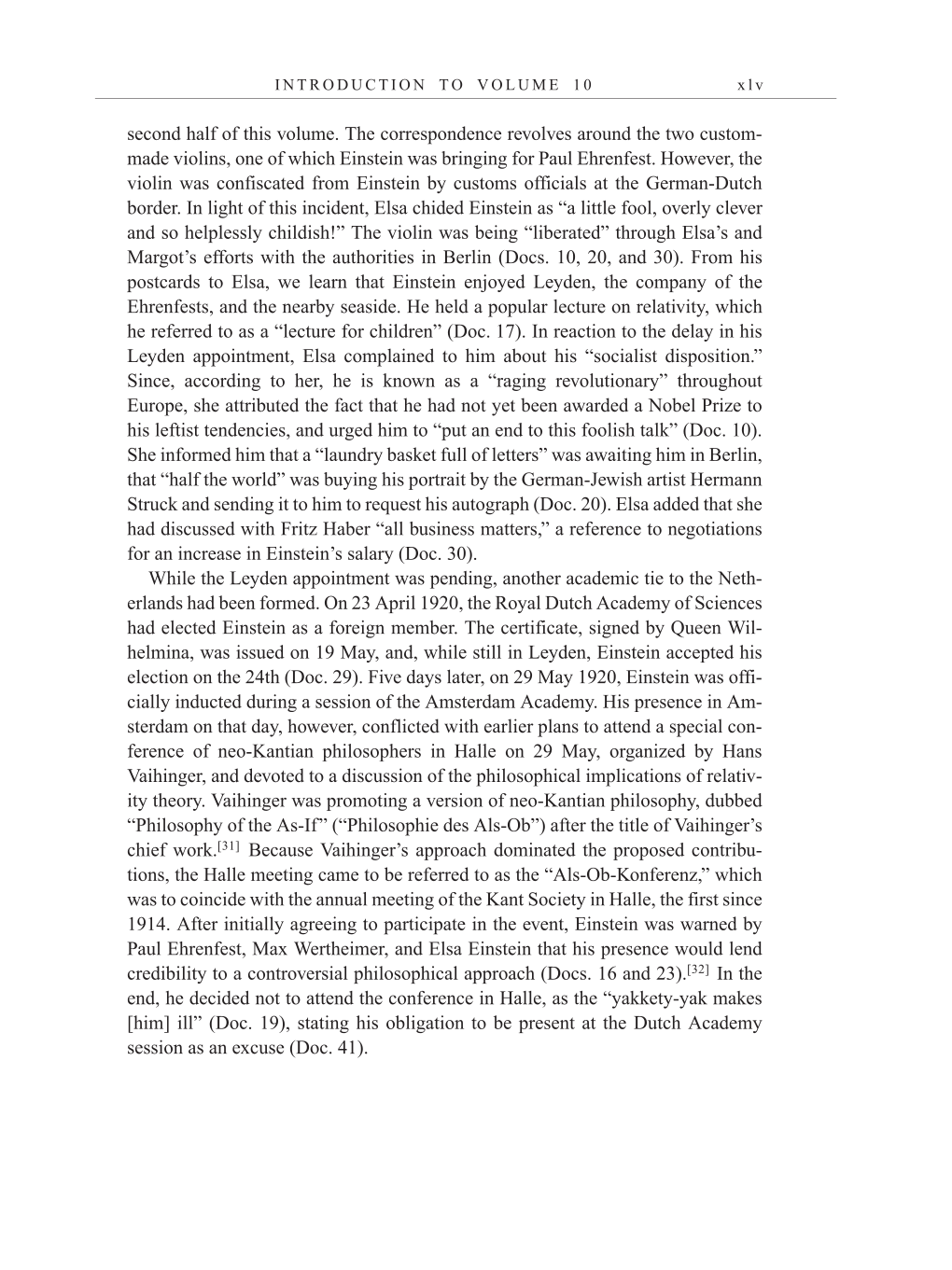I N T R O D U C T I O N T O V O L U M E 1 0 x l v
second half of this volume. The correspondence revolves around the two custom-
made violins, one of which Einstein was bringing for Paul Ehrenfest. However, the
violin was confiscated from Einstein by customs officials at the German-Dutch
border. In light of this incident, Elsa chided Einstein as “a little fool, overly clever
and so helplessly childish!” The violin was being “liberated” through Elsa’s and
Margot’s efforts with the authorities in Berlin (Docs. 10, 20, and 30). From his
postcards to Elsa, we learn that Einstein enjoyed Leyden, the company of the
Ehrenfests, and the nearby seaside. He held a popular lecture on relativity, which
he referred to as a “lecture for children” (Doc. 17). In reaction to the delay in his
Leyden appointment, Elsa complained to him about his “socialist disposition.”
Since, according to her, he is known as a “raging revolutionary” throughout
Europe, she attributed the fact that he had not yet been awarded a Nobel Prize to
his leftist tendencies, and urged him to “put an end to this foolish talk” (Doc. 10).
She informed him that a “laundry basket full of letters” was awaiting him in Berlin,
that “half the world” was buying his portrait by the German-Jewish artist Hermann
Struck and sending it to him to request his autograph (Doc. 20). Elsa added that she
had discussed with Fritz Haber “all business matters,” a reference to negotiations
for an increase in Einstein’s salary (Doc. 30).
While the Leyden appointment was pending, another academic tie to the Neth-
erlands had been formed. On 23 April 1920, the Royal Dutch Academy of Sciences
had elected Einstein as a foreign member. The certificate, signed by Queen Wil-
helmina, was issued on 19 May, and, while still in Leyden, Einstein accepted his
election on the 24th (Doc. 29). Five days later, on 29 May 1920, Einstein was offi-
cially inducted during a session of the Amsterdam Academy. His presence in Am-
sterdam on that day, however, conflicted with earlier plans to attend a special con-
ference of neo-Kantian philosophers in Halle on 29 May, organized by Hans
Vaihinger, and devoted to a discussion of the philosophical implications of relativ-
ity theory. Vaihinger was promoting a version of neo-Kantian philosophy, dubbed
“Philosophy of the As-If” (“Philosophie des Als-Ob”) after the title of Vaihinger’s
chief
work.[31]
Because Vaihinger’s approach dominated the proposed contribu-
tions, the Halle meeting came to be referred to as the “Als-Ob-Konferenz,” which
was to coincide with the annual meeting of the Kant Society in Halle, the first since
1914. After initially agreeing to participate in the event, Einstein was warned by
Paul Ehrenfest, Max Wertheimer, and Elsa Einstein that his presence would lend
credibility to a controversial philosophical approach (Docs. 16 and
23).[32]
In the
end, he decided not to attend the conference in Halle, as the “yakkety-yak makes
[him] ill” (Doc. 19), stating his obligation to be present at the Dutch Academy
session as an excuse (Doc. 41).
